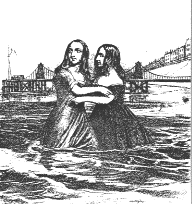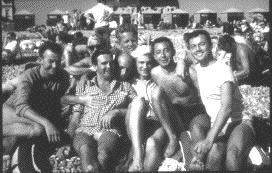Brighton's history
Below is a brief outline of some of what we know about Brighton's queer past.
For a more detailed journey back through time, see A History of Lesbian & Gay Brighton.
When Brighton began to flourish as a pleasure resort at the end of the eighteenth century under the patronage of the Prince of Wales, he cannot have imagined that the small fishing town would one day become the Gay Capital of the South. Despite harsh legal penalties (the last man to be executed for buggery was hanged in 1835), evidence suggests that a floating population of holiday makers and good transport links with London (followed by the coming of the railway in 1841) together provided the ideal conditions for the 'unmentionable crimes' practised by the 'improper characters in the habit of coming to Brighton'.
Many men were initially drawn to Brighton by the enormous numbers of soldiers garrisoned here during the Napoleonic Wars. In August 1822, George Wilson, a servant from Newcastle-upon-Tyne, was accused by a guardsman he had met in the Duke of Wellington public house in Pool Valley of having offered him a sovereign and two shillings to go with him onto the beach to commit an unnatural crime.
Also in August of that year, a tradesman in Shoreham was compelled to abscond following the discovery of a 'most unaccountable propensity'. His outraged neighbours assembled, burnt the fugitive in effigy and were with difficulty prevented by his wife from pulling his house down.
In May 1836, Stanley Stokes, a London solicitor who had been making sexual approaches to a groom at the New Ship Hotel, was mobbed and tarred and cut his own throat in East Street, dying two days later.
Happily, history also records that in January 1837, a man who had 'made a proposition of a disgusting nature' to a Grenadier Guard on sentry duty at the Royal Pavilion was allowed to escape by the arresting officers (who were perhaps mindful of the Stokes case the year before).
In the absence of the legal records which are such a fruitful source for accounts of men caught with their trousers down, the early history of lesbianism must be cobbled together from conjecture and scraps of rumour. Many letters and diaries were discreetly destroyed; others such as the secret diaries of Yorkshire heiress Anne Lister have only recently been decoded and published.
 In the nineteenth century, two spinsters might set up house and spend much of their lives together without exciting any comment. Philanthropist Angela Burdett-Coutts (1814-1906), spent part of each year on holiday at the Royal Albion Hotel in Brighton with her companion Hannah. The couple were devoted to each other, were socially recognised as a pair, even sent joint Christmas cards, and when Hannah died in 1878, Miss Burdett-Coutts told a friend that she was utterly crushed by the loss of 'my poor darling, the companion and sunshine of my life for 52 years'. Though such romantic partnerships were accepted by the world at large, they may in fact - behind closed doors - have been little different from the long-term lesbian relationships of today.
In the nineteenth century, two spinsters might set up house and spend much of their lives together without exciting any comment. Philanthropist Angela Burdett-Coutts (1814-1906), spent part of each year on holiday at the Royal Albion Hotel in Brighton with her companion Hannah. The couple were devoted to each other, were socially recognised as a pair, even sent joint Christmas cards, and when Hannah died in 1878, Miss Burdett-Coutts told a friend that she was utterly crushed by the loss of 'my poor darling, the companion and sunshine of my life for 52 years'. Though such romantic partnerships were accepted by the world at large, they may in fact - behind closed doors - have been little different from the long-term lesbian relationships of today.
Other early records have an unmistakable flavour of an almost modern-day dykiness. In the 1870s Miss Harriet Rowell, who taught swimming at Brill's Baths under the name of Miss Elphinstone Dick, won local fame for herself with a series of public swimming feats including a 2 hour 43 minute swim in a rough September sea from Shoreham to Brighton. Harriet fell in love with a Brighton woman, Alice Moon, and the couple emigrated to Australia where they started a women's gymnasium and taught gymnastics.
By the 1920s and 30s Brighton was well-established on the queer social map as 'the place to go and let your hair down'. Pubs with a lesbian or gay clientele were flourishing - among these the Star of Brunswick in Brunswick Street West and Pigott's bar at the St James Tavern in Madeira Place were especially popular with the boys and girls respectively. Radclyffe Hall came to party - 'we all talked and howled till 1.30 am'; there were women-only tea dances at the Royal Albion Hotel and in 1929 the Brighton Man-Woman hit the headlines. Lillias Arkell-Smith, a lesbian masquerading as Colonel Sir Victor Ivor Gauntlett Blyth Barker (man-about-town, huntsman and cricketer), had wooed a Brighton woman, married her at St Peter's church and honeymooned at the Grand Hotel. Lillias, regarded by Radclyffe Hall as a 'mad pervert of the most undesirable kind', was found guilty of describing herself as a bachelor in a register of marriage and sentenced to nine months' imprisonment. The Evening Argus muttered to its readers that 'there are obvious difficulties in discussing the case'.
During the Second World War Brighton was again full of available soldiers - Australians and Canadians -
'You used to meet them round the Clock Tower and off you'd go, there was plenty of places because of the blackout'.
 Women and men in the forces who were away from home meeting other lesbians and gay people for the first time in their lives also heard about Brighton and its special pleasures - later they came from all over the country to visit and many stayed to make their homes here and helped turn Brighton into a Shangri-La in the post-war years. One gay man moved down from London just after the war and made his first gay friends on the newly-reopened men's beach in Hove:
Women and men in the forces who were away from home meeting other lesbians and gay people for the first time in their lives also heard about Brighton and its special pleasures - later they came from all over the country to visit and many stayed to make their homes here and helped turn Brighton into a Shangri-La in the post-war years. One gay man moved down from London just after the war and made his first gay friends on the newly-reopened men's beach in Hove:
'As far as I know, it was the only place in England with a notice up - MEN'S BEACH ONLY - and there was even somebody there that chased women off if they meandered onto it. There was so much beauty down there, it was too fantastic. All these people that came down on holidays, there was nothing in the rest of the country to compare. They would take bottles down and have parties. Of course they never went in the sea, they never got their beautiful bikinis wet. "Oh my God no, I'm afraid of the water!" They just went to be seen. It was fun, flagrant fun.'
